Overview
In the broadest definition, a sensor is a device, module, machine, or subsystem whose purpose is to detect events or changes in its environment and send the information to other electronics, frequently a computer processor.
A good sensor obeys the following rules:
- it is sensitive to the measured property
- it is insensitive to any other property likely to be encountered in its application, and
- it does not influence the measured property.
Most sensors have a linear transfer function. The sensitivity is then defined as the ratio between the output signal and measured property. In addition, an offset is frequently added or subtracted. For example, −40 must be added to the output if 0 V output corresponds to −40 C input.
For an analog sensor signal to be processed, or used in digital equipment, it needs to be converted to a digital signal, using an analog-to-digital converter.
Types of sensors
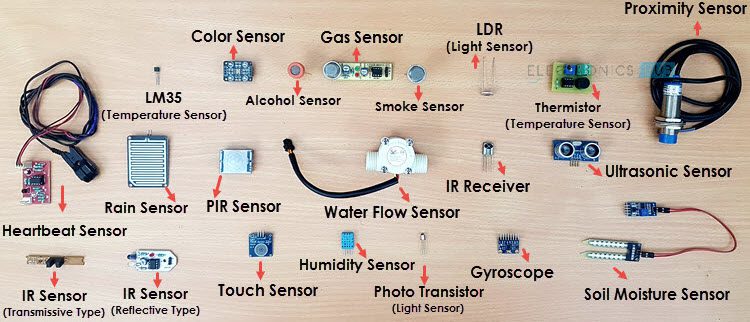
LDR (Light Dependent Resistor).
It is a device, whose resistance varies according to intensity of light it is subjected to. More light means less resistance and vice versa.

Temperature Sensor
- Negative Temperature Coefficient (NTC) thermistor: provides a very high resistance at low temperatures. High accuracy (0.05 to 1.5 °C), range from -50 to 150 °C (or 250 °C for glass ones)
- Resistance Temperature Detector (RTD): measures temperature by correlating the resistance of the RTD element with temperature. High accuracy (0.1 to 1 °C), wide range from -200 to 600 °C.
- Thermocouple: consists of two wires of different metals connected at two points. The varying voltage between these two points reflects proportional changes in temperature. Thermocouples are nonlinear, requiring conversion when used for temperature control and compensation (typically with a lookup table). Low accuracy (0.5 °C to 5 °C), widest range from -200 °C to 1750 °C.
- Semiconductor-based sensors: Low accuracy (1 °C to 5 °C), narrowest range from -70 °C to 150 °C.
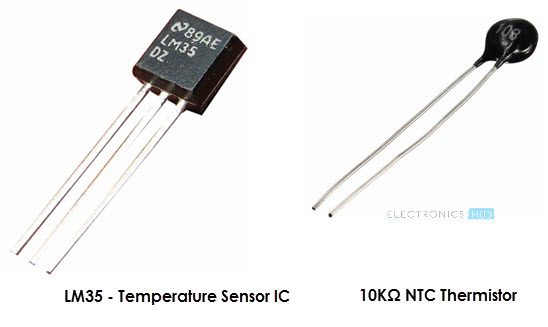
Proximity Sensor
A proximity sensor is a sensor able to detect the presence of nearby objects without any physical contact. A proximity sensor often emits an electromagnetic field or a beam of electromagnetic radiation (infrared, for instance), and looks for changes in the field or return signal. The object being sensed is often referred to as the proximity sensor’s target. Different proximity sensor targets demand different sensors. For example, a capacitive proximity sensor or photoelectric sensor might be suitable for a plastic target; an inductive proximity sensor always requires a metal target.
Proximity sensors can have a high reliability and long functional life because of the absence of mechanical parts and lack of physical contact between the sensor and the sensed object.

Accelerometer
Accelerometers are devices that measure acceleration, which is the rate of change of the velocity of an object. They measure in meters per second squared (m/s2) or in G-forces (g). A single G-force for us here on planet Earth is equivalent to 9.8 m/s2, but this does vary slightly with elevation (and will be a different value on different planets due to variations in gravitational pull). Accelerometers are useful for sensing vibrations in systems or for orientation applications.
https://learn.sparkfun.com/tutorials/accelerometer-basics/all

IR Sensor
There are two types of Infrared or IR Sensors: Transmissive Type and Reflective Type. In Transmissive Type IR Sensor, the IR Transmitter (usually an IR LED) and the IR Detector (usually a Photo Diode) are positioned facing each other so that when an object passes between them, the sensor detects the object.
The other type of IR Sensor is a Reflective Type IR Sensor. In this, the transmitter and the detector are positioned adjacent to each other facing the object. When an object comes in front of the sensor, the sensor detects the object.
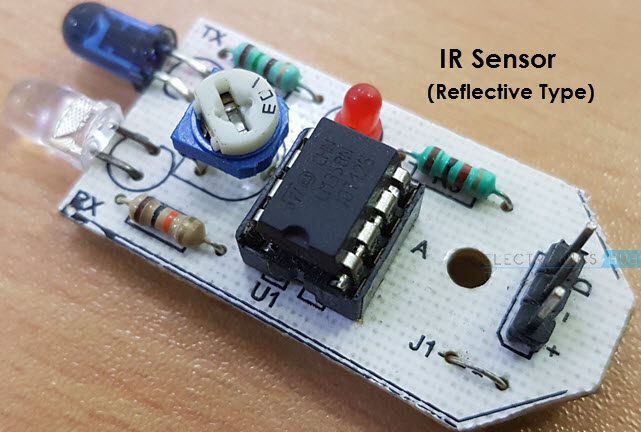
PIR Sensor (Passive Infrared Sensor)
An electronic sensor that measures infrared (IR) light radiating from objects in its field of view. They are most often used in PIR-based motion detectors (security alarms, automatic lighting applications). PIR sensors detect general movement, but do not give information on who or what moved. For that purpose, an active IR sensor is required. The term passive refers to the fact that PIR devices do not radiate energy for detection purposes. They work entirely by detecting infrared radiation (radiant heat) emitted by or reflected from objects.

Pressure Sensor
A device for pressure measurement of gases or liquids. Pressure is an expression of the force required to stop a fluid from expanding, and is usually stated in terms of force per unit area. A pressure sensor usually acts as a transducer; it generates a signal as a function of the pressure imposed.

Tactile Sensor
A device that measures information arising from physical interaction with its environment. Tactile sensors may be of different types including piezoresistive, piezoelectric, capacitive and elastoresistive sensors Examples:
- Force/torque sensor: are used in combination with a tactile array to give the information for force control

- Dynamic sensor: effectively detect the making and breaking of contact

- Thermal sensor
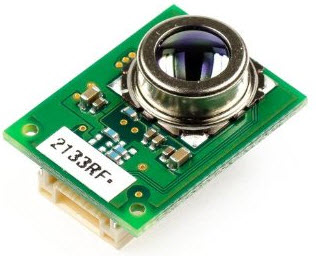
Ultrasonic Sensor
An Ultrasonic Sensor is a non-contact type device that can be used to measure distance as well as velocity of an object. An Ultrasonic Sensor works based on the properties of the sound waves with frequency greater than that of the human audible range.
Using the time of flight of the sound wave, an Ultrasonic Sensor can measure the distance of the object (similar to SONAR). The Doppler Shift property of the sound wave is used to measure the velocity of an object.
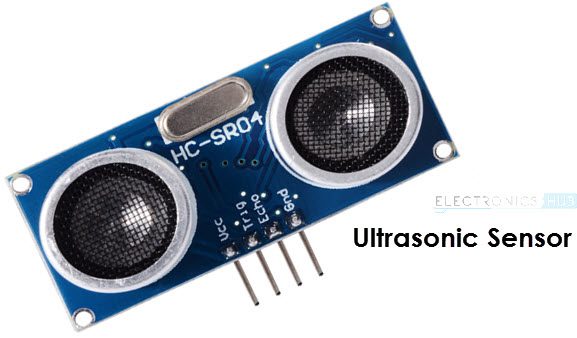
Smoke, Gas and Alcohol Sensor
Touch Sensor
Color Sensor
Humidity Sensor
Tilt Sensor
Flow and Level Sensor
Potentiometer
A potentiometer is a three-terminal resistor with a sliding or rotating contact that forms an adjustable voltage divider. If only two terminals are used, one end and the wiper, it acts as a variable resistor or rheostat.
- slide pot or slider pot: a potentiometer that is adjusted by sliding the wiper left or right (or up and down, depending on the installation), usually with a finger or thumb
- thumb pot or thumbwheel pot: a small rotating potentiometer meant to be adjusted infrequently by means of a small thumbwheel
- trimpot or trimmer pot: a trimmer potentiometer typically meant to be adjusted once or infrequently for “fine-tuning” an electrical signal

Other useful terms
Breakout board
The basic concept of a breakout board is that is takes a single electrical component and makes it easy to use.
Usually the electrical component is an integrated circuit (IC). Integrated circuits, as you may know, have pins on them. The pins on an IC can do a multitude of things, but you usually have pins for supply power, pins for providing a ground, pins for receiving an input and pins for sending an output.
A breakout board “breaks out” these pins onto a printed circuit board that has its own pins that are spaced perfectly for a solderless breadboard, giving you easy access to use the integrated circuit.
There are all type of breakout boards – but most of them are for different types of sensors, for example: accelerometers, ultrasonic distance sensors, RFID tag sensors, temperature sensors, pressure sensors, and they even have seismic breakout boards for sensing dinosaurs’ footsteps! https://programmingelectronics.com/what-is-a-breakout-board-for-arduino/
Resistor color code calculator
 https://www.allaboutcircuits.com/tools/resistor-color-code-calculator/
https://www.allaboutcircuits.com/tools/resistor-color-code-calculator/
Sources
https://en.wikipedia.org/wiki/List_of_sensors https://www.electronicshub.org/different-types-sensors/ https://en.wikipedia.org/wiki/Sensor https://www.ametherm.com/blog/thermistors/temperature-sensor-types https://www.dimensionengineering.com/info/accelerometers https://appmeas.co.uk/resources/pressure-measurement-notes/what-is-the-output-from-a-pressure-sensor-with-an-inbuilt-amplifier/